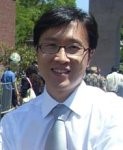Date
Cost
Free and open to the public
Location
Physical Science Building, Room 160
Description
Abstract:
Heterostructured semiconductors with different electronic structures have been a key in a new generation of electronic and optoelectronic devices such as p-n junctions, sensors, field effect transistors, memories, and photovoltaics. A majority of these devices available in modern semiconductor technologies are based on crystalline thin film semiconductors such as III-VI compounds, which often require highly sophisticated growth techniques to satisfy complicated material property constrictions including lattice mismatch relaxation. These challenges make them prohibitively expensive, which coupled with their limited compatibility with realizing novel functionalities (e.g., mechanical flexibility) hinder their widespread applications in emerging device technologies. Recently rediscovered atomically thin two-dimensional (2D) semiconductors such as transition metal dichalcogendies (TMDs; e.g., MoS2 and WS2) present exciting and unique opportunities beyond what is possible by conventional Silicon or III-V compound semiconductors. These materials not only push the miniaturization of current technologies down to the ultimate size limit – atomic thickness – but exhibit rich materials properties untenable otherwise (e.g., tunable band gap and extremely high strain limit), thus offering vast opportunities for emerging technologies. One of the most intriguing features is their anisotropic bonding by weak van der Waals (vdW) attraction which enables the assembly of multiple 2D TMDs even with huge lattice mismatch, unlike conventional III-V thin film counterparts. From the industrial point of view, the intrinsic cost-effectiveness inherent to the growth of 2D TMDs further make them highly attractive for large-scale device applications. In order to realize the technological potential of these emerging materials, it is critically essential to manufacture them in a highly scalable and controlled manner so that they can preserve and translate their exotic nanoscale properties up to practical device levels. Conventional fabrication approaches have relied on the low-yield uncontrolled manual exfoliation and stacking of individual 2D TMD layers, which remain impractical for scaled-up applications. In this talk, I will present novel strategies to rationally integrate multiple 2D TMDs in a highly scalable and controlled manner to overcome the current limitations of 2D TMDs preparation. Specifically, I will introduce a novel chemical vapor deposition (CVD)-based manufacturing process which enables the wafer-scale (> few cm2), vertical stacking of multiple 2D TMD layers with controlled morphologies, uniform electrical properties and precisely defined heterointerfaces. This scalable CVD method has been enabled by the metal-seed layer assisted growth of individual 2D TMDs, which is based on our recent findings that the morphologies of metal seed precursors critically dictate those of resulting 2D TMDs. Detailed structural characterizations based on extensive transmission electron microscopy (TEM) techniques combined with electrical transport measurements directly evidence that these hybrid materials preserve the structural integrity of constituting 2D components, suggesting their high feasibility for large-scale CMOS-compatible manufacturability. This CVD method has been further extended to engineer the growth orientation of 2D TMDs, which also led to the development of wafer-scale 2D TMDs with vertically-aligned 2D layers exposing 2D edge sites only on their surfaces. These studies emphasize the importance of controlling the morphologies of 2D TMDs for their tailored materials/device functionalities, providing essential guidelines for designing versatile 2D TMDs toward emerging transformative technologies. As a forward-looking perspective, I envision that these uniquely designed 2D TMDs will be applied to a large range of technologies, including high-performance gas/biomolecule sensors, extremely flexible/transparent optoelectronic devices, as well as smart energy devices, which will be discussed as future directions.
Biography:
Dr. Jung received his B.S., M.S., and Ph.D. in Materials Science and Engineering from Seoul National University, University of Illinois-Urbana Champaign, and University of Pennsylvania, respectively. Prior to joining NSTC, he was a postdoctoral associate at Yale University where he worked with Profs. Mark Reed and Judy Cha. His research interests include low-dimensional electronic materials such as 2D semiconductors, with a primary focus on the fundamental understanding of their structure-property relationships and their large-scale integrations for practical applications in emerging electronics, optoelectronics and energy areas. He is the recipient of MRS graduate silver award and S.J. Stein prize, and his works have been cited ~1300 times.
Presenter

Yeonwoong (Eric) Jung, Ph.D.
NanoScience Technology Center University of Central Florida
More information
Light refreshments will be served
Contact
Rebeca Barrios NanoScience Technology Center 407-882-1515 NSTCsearch@ucf.edu